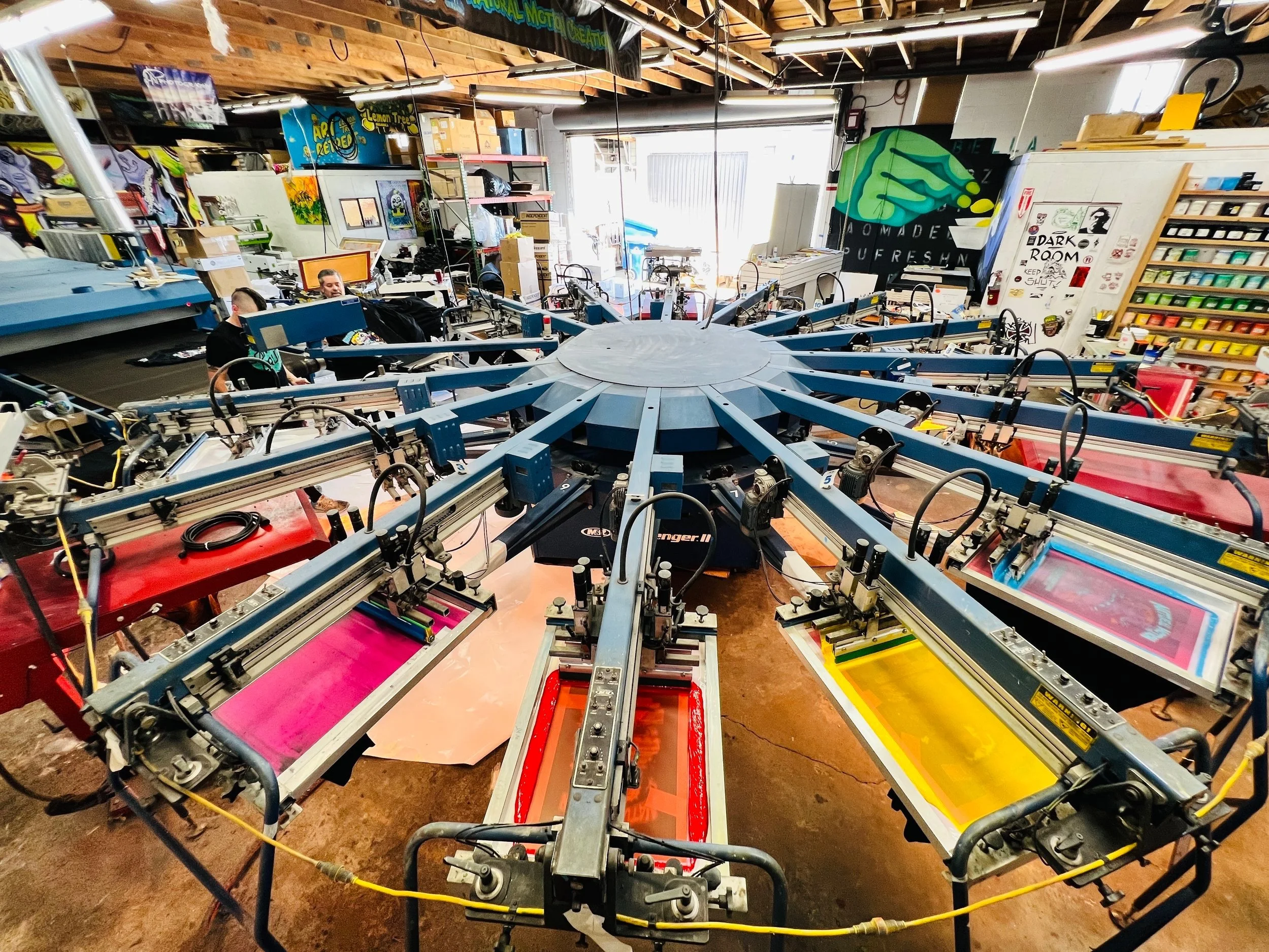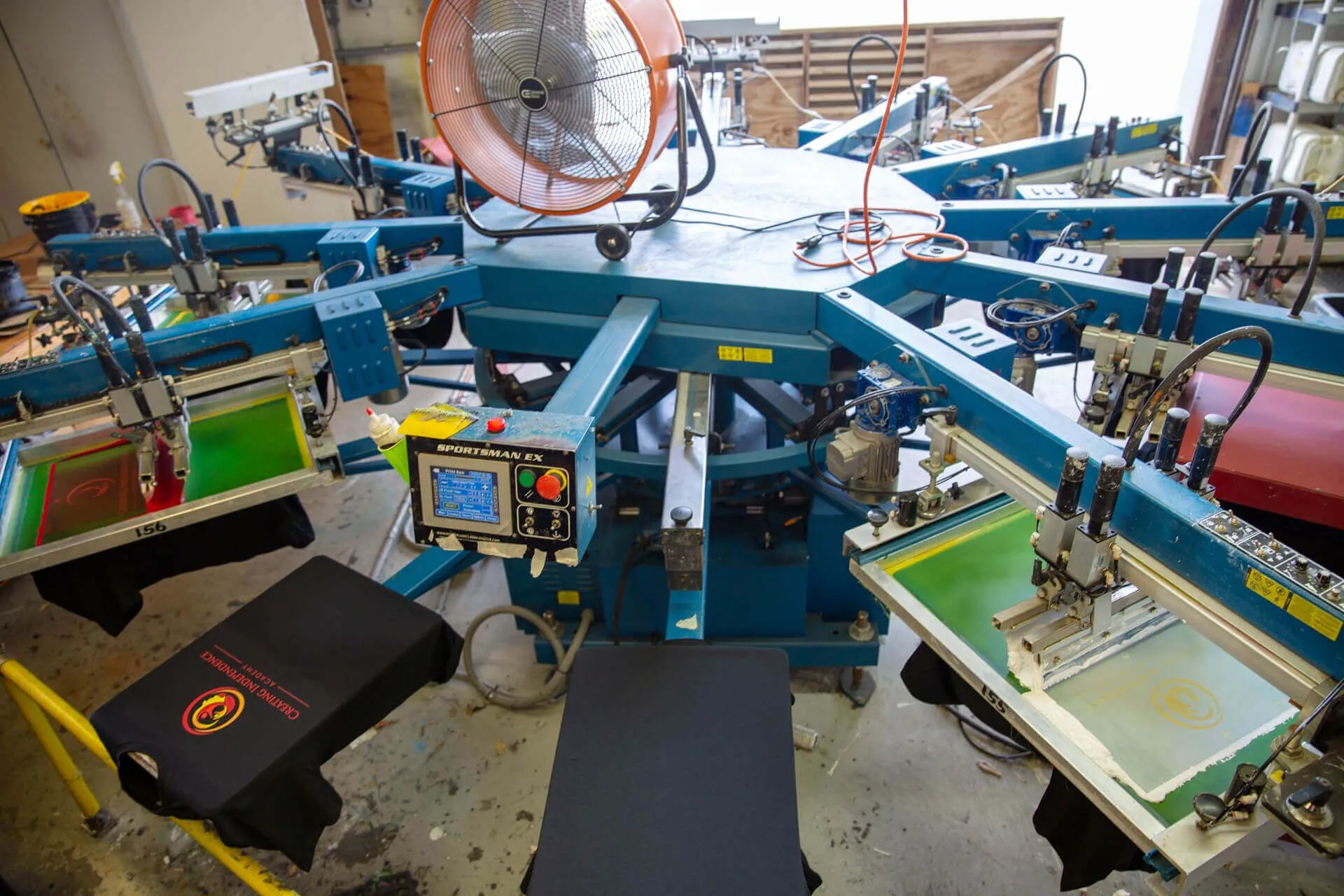Best Local T-Shirt Printing for Personalized Apparel
Screen Printing Uncovered: Whatever You Required to Understand About Tee and Garment Printing Methods
Screen printing is an interesting approach that incorporates art with method, supplying limitless opportunities for creative thinking. Prepared to discover the necessary elements that make screen publishing an art type?
The Essentials of Display Printing: Exactly How It Functions
When you plunge into screen printing, you'll uncover it's both a scientific research and an art. At its core, display printing involves producing a pattern, or screen, that allows ink to travel through only in specific locations (screen printing kit). You start by picking your style and preparing your screen with a light-sensitive emulsion. When you expose this emulsion to light, it sets, leaving your layout as an unfavorable space.
Placement the display over the textile, after that make use of a squeegee to push ink via the screen onto the garment. Each step is essential, and understanding them will certainly raise your screen printing skills, transforming straightforward garments into special, meaningful items.
Sorts Of Display Printing Methods
Once you comprehend the essentials of screen printing, it's time to discover the numerous methods that can raise your designs. One prominent technique is standard display printing, where ink is pushed with a stenciled display. This technique is excellent for strong, dynamic shades. There's water-based ink printing, which uses a softer feel and is eco-friendly, yet it requires a different method to healing.
If you're intending for great details, think about discharge printing. This strategy removes dye from the textile, leaving a soft, vintage look. Another alternative is plastisol printing, recognized for its sturdiness and dazzling colors, making it a preferred for several brand names. Experiment with halftone printing to produce gradient impacts and complex designs. Each strategy has its unique charm, so do not think twice to try them bent on discover what matches your style best!
Vital Devices for Display Printing
To accomplish magnificent results in screen printing, having the ideal tools is essential. You'll require a sturdy display printing structure, which holds the mesh that transfers your layout onto the garment. Next off, spend in high-grade mops; these are important for applying ink uniformly throughout the display.
Choosing the Right Inks and Products
When choosing inks and materials for screen printing, you require to take into consideration the kind of ink that works best for your job. Believe regarding textile compatibility to assure your layouts look great and last lengthy. Likewise, explore environmentally friendly ink alternatives to make your printing process a lot more sustainable.
Types of Display Inks
Choosing the appropriate display ink is necessary for accomplishing vivid, long lasting prints that satisfy your job's requirements. There are several kinds of display inks to examine. Plastisol ink is popular for its convenience and ease of use, giving outstanding shade opacity on dark materials. Water-based ink, on the various other hand, provides a softer feel and is environmentally friendly, making it excellent for those aiming to lessen their ecological effect. Discharge inks remove color from the textile, leading to a soft, classic look but need certain handling. Ultimately, specialty inks, such as glow-in-the-dark or metallic, can include special impacts to your layouts. Assess your project needs and select the ink that aligns ideal with your preferred outcome.

Textile Compatibility Considerations
Understanding material compatibility is vital for achieving top notch screen prints, especially considering that various products respond uniquely to numerous inks. When selecting inks, consider the textile kind-- cotton, polyester, or blends. For cotton, water-based inks work well, supplying soft qualities and breathability. Polyester, on the various other hand, typically requires plastisol inks for far better adhesion and dynamic shades. You may require to use a combination of both kinds if you're publishing on blends. Constantly check your inks on example textile to assure they stick properly and preserve color integrity. Additionally, keep in mind that textile weight and appearance can impact the final end result, so selecting the right ink and product combination is important for your project's success.
Eco-Friendly Ink Options
Environment-friendly inks are coming to be a popular choice for display printers who desire to lessen their environmental effect while preserving quality. When selecting inks, consider water-based inks, which are less hazardous and simpler to clean up compared to traditional solvents.
In addition, try to find inks made from renewable resources, such as soy or vegetable-based choices. By picking the right inks and materials, you'll not just produce spectacular designs but likewise contribute to a more lasting printing process. Make the switch, and your prints will site link reflect your commitment to the atmosphere!
Preparing Your Design for Display Printing

Submit Format Requirements
To ensure your layout looks dynamic and sharp on textile, you'll need to pay close interest to file format demands for screen printing. Beginning with vector files like AI or EPS, as they can be scaled without losing top quality. If you use raster pictures, decide for high-resolution documents, such as TIFF or PNG, preferably at 300 DPI. Avoid using JPEGs, as they can shed clarity when resized. Make sure your layout has a transparent history to avoid undesirable white sides on your prints. Maintain shade settings in mind; CMYK is standard for screen printing, so transform your RGB designs appropriately - screen printing kit. By complying with these guidelines, you'll establish your art work up for an effective print.
Shade Splitting Up Methods
Shade separation is a necessary action in preparing your style for display printing, and understanding it can considerably improve your print top quality. You'll need to damage your design into specific shades, as each color requires a different screen throughout printing. Begin by recognizing all the colors in your layout and develop layers each. You can use software like Adobe Photoshop or Illustrator to isolate and different colors properly. Be specific to save each layer as a separate data, commonly in a layout like TIFF or PSD. This precision not just ensures precise shade representation yet likewise simplifies the printing process. By paying focus to color splitting up, you'll achieve specialist and dynamic cause your screen-printed garments.
Resolution and Dimension
Attaining the most effective lead to screen printing begins with assuring your style has the ideal resolution and size. Ideally, your artwork ought to be at least 300 DPI (dots per inch) for sharp, clear prints. If you utilize lower resolution, your end product could look pixelated and why not check here amateur.
When it pertains to size, take into consideration the measurements of your print location. Layout your artwork to match the final print dimension, preferably producing it in the real measurements you'll be publishing. By doing this, you'll stay clear of any type of unforeseen scaling issues.
Always check your layout in both vector and raster styles. Vector graphics can be scaled without shedding high quality, making them ideal for display printing. Preparing properly will guarantee your layout looks remarkable on every garment!
Step-by-Step Screen Printing Refine
Screen printing is a vibrant procedure that permits you to create dynamic layouts on various surfaces. To start, you'll need a display, emulsion, and your chosen ink. Prepare your display by cleaning it completely. Next, apply original site the solution evenly and allow it completely dry in a dark location. Once completely dry, reveal your display to light with your layout positioned on it, which will certainly set the emulsion where the light hits, creating a stencil - screen printing kit.
Pour ink onto the display and utilize a squeegee to press the ink with the pattern onto the material. Raise the display carefully and let the print dry. You have actually efficiently display published your design.
Tips for Successful Display Printing Projects
While you're diving right into your display printing jobs, bear in mind that preparation is essential to success. Start by gathering all your products-- inks, screens, garments, and squeegees. A clean work area aids avoid undesirable errors, so neat up prior to you begin.
Next, validate your artwork is high-resolution and properly sized for your garment. Evaluate your screen for proper exposure and tidy it thoroughly to stay clear of spots. When blending your inks, comply with the supplier's standards to achieve the appropriate uniformity.
During printing, apply also pressure with your squeegee for constant results. Don't hurry; take your time to confirm each print meets your standards. After printing, let your garments completely dry entirely before taking care of or packaging them.
Last but not least, always maintain a sample of your job for future recommendation. By doing this, you can examine your progression and enhance your methods over time. Pleased printing!

Often Asked Concerns
The length of time Does It Take to Establish up a Display Printing Work?
Establishing a screen printing job generally takes around 30 mins to an hour. You'll prepare the screens, mix inks, and readjust the press. The moment differs based on complexity and experience, so stay organized!
Can I Print on Different Fabric Types Making Use Of the Very Same Technique?
Yes, you can print on various fabric kinds utilizing the very same strategy, however you'll need to adjust your inks and setups. Some fabrics absorb ink in different ways, so trying out assurances the most effective results for each and every product.
What Are Common Mistakes to Prevent in Screen Printing?
When screen printing, avoid common errors like utilizing the wrong ink, overlooking appropriate direct exposure times, or missing pre-press checks. Constantly check your setup and preserve tidy displays to ensure quality results each time.
Just How Can I Effectively Clean and Maintain My Screen Printing Tools?
To correctly tidy and maintain your screen printing devices, you should routinely clean displays with appropriate solvents, inspect squeegees for wear, and guarantee all tools are stored completely dry and dust-free. Uniformity boosts and prevents expensive repair services efficiency.
Is Screen Printing Eco-friendly Contrasted to Other Approaches?
Screen printing can be extra eco-friendly than various other methods, particularly if you use eco-conscious materials and water-based inks. By choosing sustainable supplies and methods, you minimize waste and decrease your effect on the earth.
Display Printing Uncovered: Every Little Thing You Required to Know Concerning Tee and Garment Printing Methods
At its core, display printing involves producing a stencil, or display, that enables ink to pass via just in particular locations. Position the screen over the fabric, after that use a squeegee to push ink with the display onto the garment. One prominent method is conventional screen printing, where ink is pushed with a stenciled screen.When selecting inks and materials for display printing, you need to take into account the kind of ink that works finest for your task.